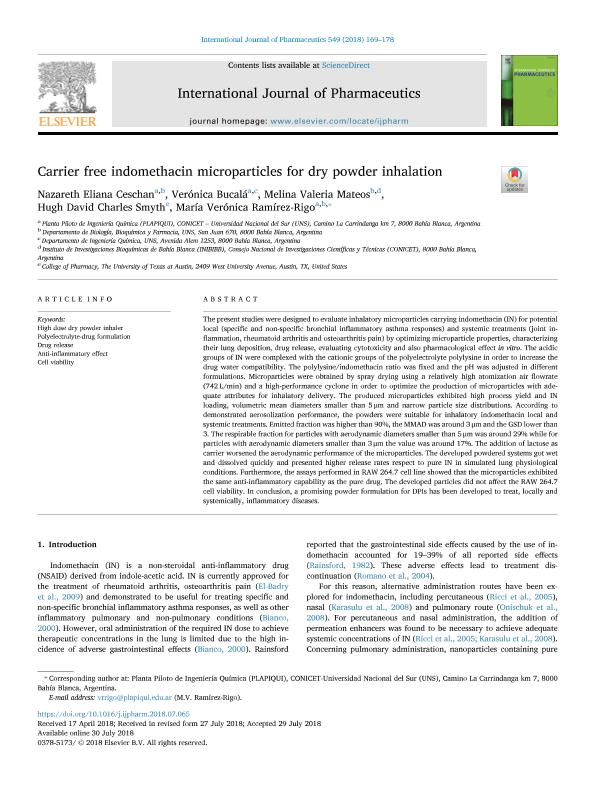Mostrar el registro sencillo del ítem
dc.contributor.author
Ceschan, Nazareth Eliana

dc.contributor.author
Bucala, Veronica

dc.contributor.author
Mateos, Melina Valeria

dc.contributor.author
Smyth, Hugh David Charles
dc.contributor.author
Ramírez Rigo, María Veronica

dc.date.available
2019-10-31T14:51:26Z
dc.date.issued
2018-10-05
dc.identifier.citation
Ceschan, Nazareth Eliana; Bucala, Veronica; Mateos, Melina Valeria; Smyth, Hugh David Charles; Ramírez Rigo, María Veronica; Carrier free indomethacin microparticles for dry powder inhalation; Elsevier Science; International Journal Of Pharmaceutics; 549; 1-2; 05-10-2018; 169-178
dc.identifier.issn
0378-5173
dc.identifier.uri
http://hdl.handle.net/11336/87727
dc.description.abstract
The present studies were designed to evaluate inhalatory microparticles carrying indomethacin (IN) for potential local (specific and non-specific bronchial inflammatory asthma responses) and systemic treatments (joint inflammation, rheumatoid arthritis and osteoarthritis pain) by optimizing microparticle properties, characterizing their lung deposition, drug release, evaluating cytotoxicity and also pharmacological effect in vitro. The acidic groups of IN were complexed with the cationic groups of the polyelectrolyte polylysine in order to increase the drug water compatibility. The polylysine/indomethacin ratio was fixed and the pH was adjusted in different formulations. Microparticles were obtained by spray drying using a relatively high atomization air flowrate (742 L/min) and a high-performance cyclone in order to optimize the production of microparticles with adequate attributes for inhalatory delivery. The produced microparticles exhibited high process yield and IN loading, volumetric mean diameters smaller than 5 μm and narrow particle size distributions. According to demonstrated aerosolization performance, the powders were suitable for inhalatory indomethacin local and systemic treatments. Emitted fraction was higher than 90%, the MMAD was around 3 μm and the GSD lower than 3. The respirable fraction for particles with aerodynamic diameters smaller than 5 μm was around 29% while for particles with aerodynamic diameters smaller than 3 μm the value was around 17%. The addition of lactose as carrier worsened the aerodynamic performance of the microparticles. The developed powdered systems got wet and dissolved quickly and presented higher release rates respect to pure IN in simulated lung physiological conditions. Furthermore, the assays performed in RAW 264.7 cell line showed that the microparticles exhibited the same anti-inflammatory capability as the pure drug. The developed particles did not affect the RAW 264.7 cell viability. In conclusion, a promising powder formulation for DPIs has been developed to treat, locally and systemically, inflammatory diseases.
dc.format
application/pdf
dc.language.iso
eng
dc.publisher
Elsevier Science

dc.rights
info:eu-repo/semantics/openAccess
dc.rights.uri
https://creativecommons.org/licenses/by-nc-sa/2.5/ar/
dc.subject
ANTI-INFLAMMATORY EFFECT
dc.subject
CELL VIABILITY
dc.subject
DRUG RELEASE
dc.subject
HIGH DOSE DRY POWDER INHALER
dc.subject
POLYELECTROLYTE-DRUG FORMULATION
dc.subject.classification
Otras Ingeniería de los Materiales

dc.subject.classification
Ingeniería de los Materiales

dc.subject.classification
INGENIERÍAS Y TECNOLOGÍAS

dc.title
Carrier free indomethacin microparticles for dry powder inhalation
dc.type
info:eu-repo/semantics/article
dc.type
info:ar-repo/semantics/artículo
dc.type
info:eu-repo/semantics/publishedVersion
dc.date.updated
2019-10-02T19:17:50Z
dc.journal.volume
549
dc.journal.number
1-2
dc.journal.pagination
169-178
dc.journal.pais
Países Bajos

dc.journal.ciudad
Amsterdam
dc.description.fil
Fil: Ceschan, Nazareth Eliana. Consejo Nacional de Investigaciones Científicas y Técnicas. Centro Científico Tecnológico Conicet - Bahía Blanca. Planta Piloto de Ingeniería Química. Universidad Nacional del Sur. Planta Piloto de Ingeniería Química; Argentina. Universidad Nacional del Sur. Departamento de Biología, Bioquímica y Farmacia; Argentina
dc.description.fil
Fil: Bucala, Veronica. Consejo Nacional de Investigaciones Científicas y Técnicas. Centro Científico Tecnológico Conicet - Bahía Blanca. Planta Piloto de Ingeniería Química. Universidad Nacional del Sur. Planta Piloto de Ingeniería Química; Argentina. Universidad Nacional del Sur. Departamento de Ingeniería Química; Argentina
dc.description.fil
Fil: Mateos, Melina Valeria. Consejo Nacional de Investigaciones Científicas y Técnicas. Centro Científico Tecnológico Conicet - Bahía Blanca. Instituto de Investigaciones Bioquímicas de Bahía Blanca. Universidad Nacional del Sur. Instituto de Investigaciones Bioquímicas de Bahía Blanca; Argentina. Universidad Nacional del Sur. Departamento de Biología, Bioquímica y Farmacia; Argentina
dc.description.fil
Fil: Smyth, Hugh David Charles. University of Texas at Austin; Estados Unidos
dc.description.fil
Fil: Ramírez Rigo, María Veronica. Consejo Nacional de Investigaciones Científicas y Técnicas. Centro Científico Tecnológico Conicet - Bahía Blanca. Planta Piloto de Ingeniería Química. Universidad Nacional del Sur. Planta Piloto de Ingeniería Química; Argentina. Universidad Nacional del Sur. Departamento de Biología, Bioquímica y Farmacia; Argentina
dc.journal.title
International Journal Of Pharmaceutics

dc.relation.alternativeid
info:eu-repo/semantics/altIdentifier/url/https://www.sciencedirect.com/science/article/pii/S0378517318305490
dc.relation.alternativeid
info:eu-repo/semantics/altIdentifier/doi/http://dx.doi.org/10.1016/j.ijpharm.2018.07.065
Archivos asociados
